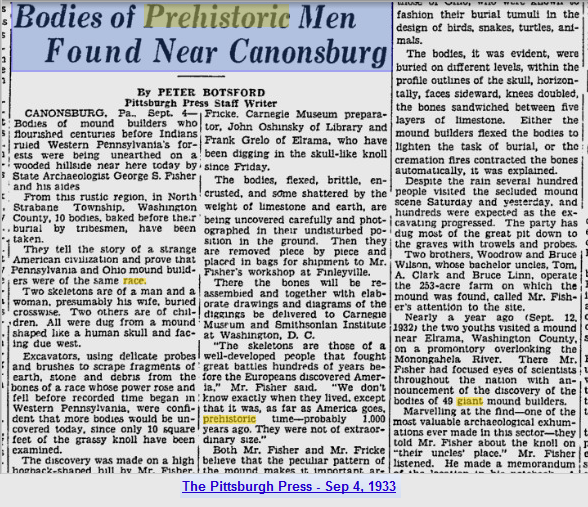Canonsburg Ancient Giants
Bodies of Prehistoric Men Found Near Canonsburg

The bodies, it was evident, were buried on different levels, within the profile outlines of the skull, horizontally, faces sideward, knees doubled, the bones sandwiched between five mound builders flexed the bodies to layers of limestone. Either the lighten the task of burial, or the cremation fires contracted the bones automatically, it was explained.
Despite the rain, several hundred people visited the secluded mound. Hundreds were expected as the excavating progressed. The party has dug most of the great pit down to the graves with trowels and probes. Two brothers, Woodrow and Bruce Wilson, whose bachelor uncles, Tom A. Clark and Bruce Linn, operate the 253-acre farm on which the mound was found, called Mr. Fisher’s attention to the site.
“The skeletons are those of a well-developed people that fought great battles hundreds of years before the Europeans discovered America,” Mr. Fisher said. “We don’t know exactly when they lived, except that it was, as far as America goes, prehistoric time-probably 1,000 years ago. They were not of extraordinary size.”
Excavators, using delicate probes and brushes to scrape fragments of earth, stone and debris from the bones of a race whose power rose and fell before recorded time began in Western Pennsylvania, were confident that more bodies would be uncovered today, since only 10 square feet of the grassy knoll have been examined.
Nearly a year ago (Sept. 12, 1932) the two youths visited a mound near Elrama, Washington County, on a promontory overlooking the Monongahela River. There Mr. Fisher had focused eyes of scientists throughout the nation with an announcement of the discovery of the bodies of 49 giant mound builders.
Both Mr. Fisher and Mr. Fricke believe that the peculiar pattern of the mound makes it an important archaeological find.
Bodies of mound builders who flourished centuries before Indians ruled Western Pennsylvania’s forests were being unearthed on a wooded hillside near here today by State Archaeologist George S. Fisher and his aides. From this rustic region, in North Strabane Township, Washington County, 10 bodies, baked before their burial by tribesmen, have been taken.
They tell the story of a strange American civilization and prove that Pennsylvania and Ohio mound builders were of the same race.
Two skeletons are of a man and a woman, presumably his wife, buried crosswise. Two others are of children. All were dug from a mound shaped like a human skull and facing due west.
In the authentic fashion, their burial tumult in the design of birds, snakes, turtles, animals. The bodies, flexed, brittle, encrusted, and some shattered by the weight of limestone and earth, are being uncovered carefully and photographed in their undisturbed position in the ground. Then they are removed piece by piece and placed in bags for shipment to Mr. Fisher’s workshop at Finleyville.
This newspaper article from 1933 reports on the excavation of a mound in North Strabane Township, Washington County, where several bodies of the mound builders were discovered. The bodies were buried on different levels, sandwiched between layers of limestone, and buried horizontally, with their faces sideward and knees doubled. The article mentions that the bodies belonged to a well-developed people who fought great battles hundreds of years before the Europeans discovered America. According to Mr. Fisher, the state archaeologist, they were not of extraordinary size.
The article further reports that the excavators were confident that more bodies would be uncovered in the area, as only 10 square feet of the grassy knoll have been examined. The article also mentions a similar discovery made by Mr. Fisher nearly a year ago in Elrama, Washington County, where 49 giant mound builders were found.
The article highlights the importance of preserving knowledge about the artifacts and culture of the mound builders. It also suggests that the peculiar pattern of the mound found in North Strabane Township makes it an important archaeological find. Overall, the article provides an interesting glimpse into the excavation of a prehistoric site and the discoveries made by archaeologists in the early 20th century.
1. The Pittsburgh Press – Sep 4, 1933 CANONSBURG,
2. 1933.09.04 – The Pittsburgh Press